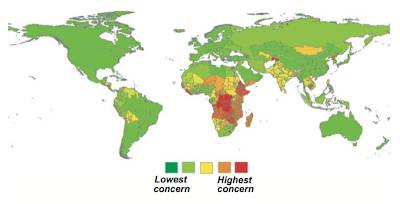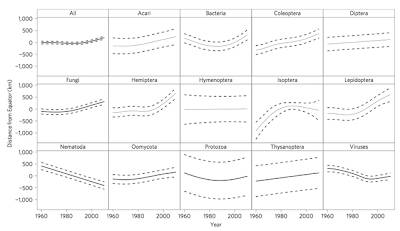Fascinating research by Daniel Bebber, Mark Ramotowski and Sarah Gurr, recently published in Nature Climate Change, looks at the impact of global warming on the movement of crop pests and other pathogens.
Pests and pathogens are a big problem for the agricultural sector with between 10 and 16 percent of crop production lost due to plant diseases and additional losses ranging from 6 to 10 percent are experienced after crops are harvested. In total, the amount of lost agricultural production would be sufficient to feed 8.5 percent of the world's total population. As shown here, food insecurity is still a huge problem for large parts of Africa and portions of Asia:
During the period from 2001 to 2003, average losses for rice (a staple of the diet of many nations) totalled 37.4 percent with 15.1 percent lost due to pests, 10.8 percent due to pathogens and 10.2 percent lost due to weeds. It is estimated that global crop losses due to disease cost the economy $220 billion, a not insignificant amount.
How and why are these pests moving to new geographic areas? Some of these pests are introduced to new areas through the transportation of crops from one area to another, however, weather is a very important factor in sustaining pests in their new environment. For example, boring pests tend to prefer drought conditions whereas chewing insects do not. The drought conditions recently experienced throughout much of the United States has increased the number of wood boring insects and has greatly impacted the health of trees and shrubs in many areas. Warming, as a whole, tends to favour increased winter survival for many insect species and tends to stimulate insects to devour more plant material. In the past, cold winter weather could be counted on to kill off the majority of insect pests in many areas of North America and Europe; unfortunately, such is no longer the case as many insects are now able to survive the less rigorous winters that we are currently experiencing.
Back to the paper by Bebber et al. Their research of 612 crop pests and pathogens shows an average annual shift of 2.7 kilometres (plus or minus 0.8 kilometres) toward polar regions since 1960. Here is a graphic that shows the movement of some key pests:
Those pests that show movement toward the equator are, in many cases, newly detected in those areas as advancements in technology in poorer, equatorial nations are now permitting the detection and treatment of pests and pathogens that were not previously monitored.
It is estimated that global food production will have to increase by 50 percent by 2050 to meet the world's needs. While global food production has doubled in the last 40 years, the movement of pests into new geographic areas may well make achieving that goal more difficult, particularly if climate change negatively impacts the viability of agricultural operations in areas that have historically been considered some of the world's key producers of food.
Click HERE to read more of Glen Asher's columns



Be the first to comment